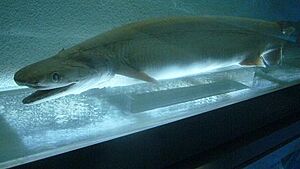Chlamydoselachidae facts for kids
Quick facts for kids Chlamydoselachidae |
|
|---|---|
 |
|
| Specimen of Chlamydoselachus anguineus from Japan | |
| Scientific classification |
|
| Kingdom: | Animalia |
| Phylum: | Chordata |
| Class: | Chondrichthyes |
| Order: | Hexanchiformes |
| Suborder: | Chlamydoselachoidei Berg and Svetovidov, 1955 |
| Family: | Chlamydoselachidae Garman, 1884 |
| Genera | |
|
|
| Synonyms | |
|
|
The Chlamydoselachidae is a special family of sharks. These sharks live deep in the ocean. They are considered very ancient, like living fossils! They belong to a larger group of sharks called Hexanchiformes.
This family is quite unique today. There are only two living families in their group. The Chlamydoselachidae is one of them. The other family includes the cow sharks.
As of 2025, we know of only two living species in this family. Both belong to the genus Chlamydoselachus. These are the famous frilled shark (C. anguineus) and the Southern African frilled shark (C. africana).
Contents
Discovering Frilled Sharks
Frilled sharks are fascinating creatures of the deep sea. They are rarely seen by humans. This is because they prefer to live in very deep waters. Their unique appearance makes them stand out.
What Makes Them Special?
These sharks get their name from their gills. They have six or seven gill slits. These slits have frilly edges. This makes them look like a ruffled collar. Their bodies are long and slender, like an eel. They can grow quite large, up to 2 meters (6.6 feet) long.
Frilled sharks are skilled hunters. They have many rows of sharp, three-pronged teeth. These teeth are perfect for catching soft-bodied prey. They often eat squid and other deep-sea fish. Scientists believe they ambush their prey.
A Look Back in Time: Ancient Sharks
The Chlamydoselachidae family has a long history. They first appeared a very long time ago. This was during the Late Cretaceous period. That's when dinosaurs still roamed the Earth! Scientists found their earliest teeth in Japan. These ancient teeth date back to the Turonian age.
Long ago, there were more types of frilled sharks. Scientists have found fossils of three different groups, or genera. These include Chlamydoselachus, Rolfodon, and Dykeius. Some of these ancient sharks were huge! For example, Rolfodon goliath and Dykeius could grow to very big sizes.
Most of these ancient types are now extinct. This means they no longer exist. Only the Chlamydoselachus genus survived. It continued to live in the deep ocean. This shows how tough and adaptable these sharks are.
The Two Living Species
As of October 15th, 2025, there are two known living species of frilled sharks:
- The Frilled Shark (Chlamydoselachus anguineus): This species is found in various deep-sea areas around the world. It is the more widely known of the two.
- The Southern African Frilled Shark (Chlamydoselachus africana): This species was identified more recently, in 2009. It lives in the deep waters off the coast of southern Africa.
Both species share many features. They both have the distinctive frilly gills. They also have long, snake-like bodies. They are both adapted to life in the dark, cold deep sea.
Extinct Relatives
Besides the two living species, many other frilled shark types once existed. Scientists have identified several extinct species within the Chlamydoselachus genus. There were also two other entire genera of frilled sharks: Dykeius and Rolfodon. These ancient relatives show us how diverse this shark family once was. They lived in deep-sea environments, just like their modern cousins.

